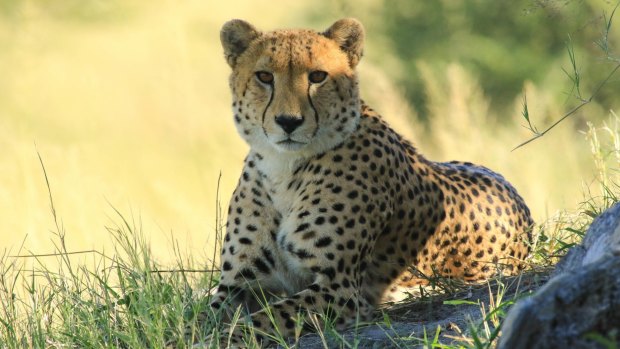This was published 5 years ago
Hwange National Park, Zimbabwe safari: Seeing cheetahs in the wild
By Kerry van der Jagt

Hwange National Park in Zimbabwe's far west is home to the big five as well as an elusive number of cheetah.
The leading lady is living up to her reputation – haughty, solitary and notoriously difficult to find. After two days and numerous false sightings the most we've seen is a tantalising glimpse of her fur coat.
"We can identify her by her trademark mole," says Vusa Ncube, our guide from Imvelo Safari Lodges. From the back of the Land Rover we scan every mound, leaf and limb for Cindy – so-called because of a scar under her right eye – a two-year-old cheetah found 10 days earlier with a poacher's snare around her neck.
"The snare was made from old copper telephone wire," says Ncube. "If the DART [Dete Animal Rescue Trust] team hadn't removed it she would have died from starvation." Our challenge is to locate Cindy and report on her condition.
We're in Hwange National Park, a 14,650-square-kilometre swathe of wilderness in Zimbabwe's far west, home to the big five as well as an elusive number of cheetah. Classified as vulnerable by the International Union for the Conservation of Nature there are about 7000 cheetahs left in the wild, mostly in southern Africa.
"There are probably fewer than 150 in all of Zimbabwe," says Mark "Butch" Butcher. "Hwange National Park is home to about 40 of them." Butcher is the managing director of Imvelo Safari Lodges, a group of lodges and camps committed to conservation and community.
"The key to protecting wildlife is to involve the local communities that live along the park's borders," says Butcher. "Where we have built lodges, poaching is in sharp decline."
Over the coming days we spend our nights at Camelthorn Lodge, built by Imvelo, not in the national park but just outside on community lands, where lease fees are paid directly to local communities. With just eight luxurious stone villas set within acacia woodlands our days are a glorious mix of game drives, pop-up breakfasts, visits to local schools, wildlife talks, night tracking and sundowners.
The afternoon sun scorches the camelthorn trees as we lurch along in our safari Rover, red dust streaming behind like twirling ribbon. On the horizon, a clump of grey boulders becomes a herd of elephants, an acacia tree erupts into a shiver of monkeys and the polished surface of a waterhole is fractured by the butterfly ears of a dozen hippos. A yellow-billed hornbill follows like an extra in a Disney movie.
As we stop to watch a herd of elephants enjoying a dust bath, the radio crackles to life with news that Cindy may have been spotted. After 30 minutes of intense searching we find her reclining against a small mound, every detail, from the top of her small head to the tip of her feather-duster tail a picture of languid perfection. Thanks to the park's small number of visitors – while Kruger has about 1.3 million visitors annually, Hwange attracts a modest 40,000 – ours is the only vehicle.
Stretched to full length, she has the contented look of the cat that got the impala. "When we found her with the snare she was really thin," says Butcher. "Now look at that fat tummy."
And for the next hour that's all we do, observe and enjoy this remarkable feline. To watch wild animals is to learn their stories, the connections they have with the environment and their interconnections with other species, including humans. Every piece, from a cheetah's paw print to a dung beetle, is part of a bigger picture, all stitched together by gossamer threads.
While the world's fastest land animal races towards extinction, it's people like Butcher and parks like Hwange that extend the hope that Africa's cast of characters will survive for future generations to see in the wild.
TRIP NOTES
Kerry van der Jagt travelled as a guest of Bench Africa and Imvelo Safari Lodges.
MORE
FLY
Qantas flies from Sydney to Johannesburg with connecting flights to Victoria Falls. See qantas.com
TOUR
Bench Africa offers an 11-day safari starting at Zambezi Sands River Camp, travelling on the 1950s overnight train Stimela Star to Hwange National Park and staying at Camelthorn and Nehimba Lodges. From $8895 a person. See benchafrica.com.au; imvelosafarilodges.com
Sign up for the Traveller Deals newsletter
Get exclusive travel deals delivered straight to your inbox. Sign up now.